Natural Sciences
72nd Graduation: Doctoral Citations – CoNAS
Published
2 years agoon
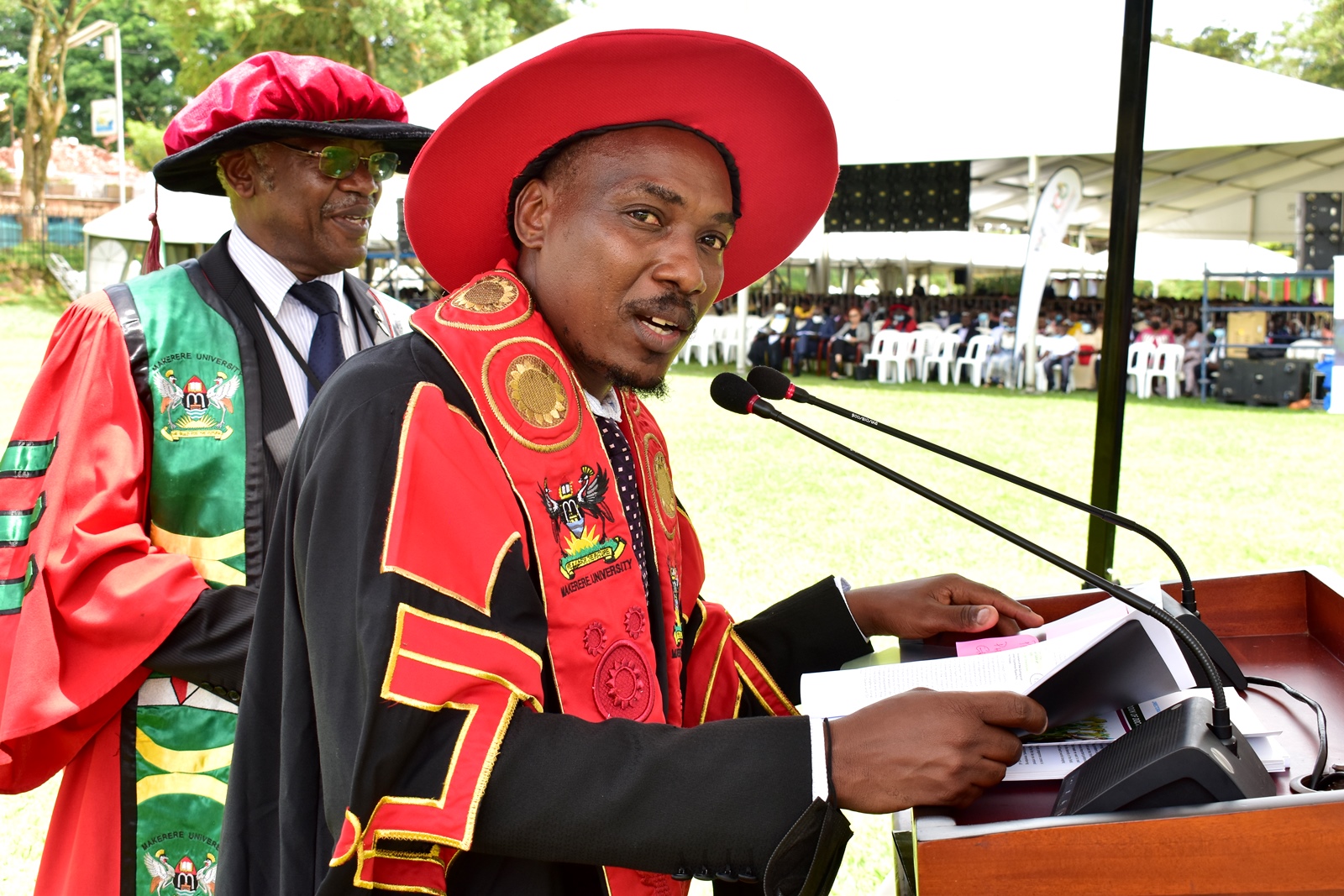

ADAKU Christopher
Chemical Structure and Properties of Anthocyanins from Selected Plant Species from Uganda.
Mr. ADAKU Christopher investigated a class of bioactive phytochemicals known as anthocyanins from selected indigenous plants, with the purpose of identifying ingredients for the development of nutraceuticals and for application as natural food colourants. This follows the increasing availability of natural health products with unsubstantiated health claims and the health concern associated with the use of synthetic food colourants. During the study, eleven new and seven known compounds were isolated and their properties deciphered. The compounds exhibited colour and stability required for food colourant application and showed remarkable antioxidant activity which is indicative of their potential beneficial health effects. These findings will lead to the development of nutraceuticals and other natural health products with guaranteed safety and efficacy. The isolated compounds can also be used as natural functional food colurants, especially for colouring refrigerated foods such as yoghurt, ice cream and beverages. This study was funded by SIDA through DRGT and MUTHI and supervised by Prof. Byamukama Robert and Prof. Kiremire Bernard (RIP).
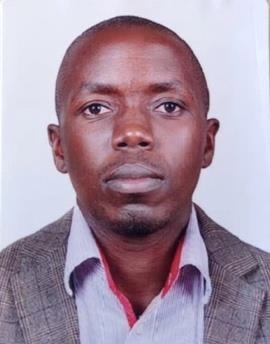
ANYWAR Godwin
Ethnopharmacology, cytotoxicity, antiviral and immunomodulatory profiles of medicinal plant species used by herbalists in treating people living with HIV/AIDS in Uganda
Mr. ANYWAR Godwin investigated the cytotoxicity, antiviral activity and immunomodulatory potential of medicinal plant species used by herbalists to treat people living with HIV/AIDS (PLHIV) in Uganda. The study was motivated by the fact that PLHIV widely use untested herbal medicines even when already on antiretroviral treatment. The results from this study showed several plant species are mainly used to treat opportunistic infections among PLHIV. Two of the most widely used plant species, Albizia coriaria and Warburgia ugandensis were highly toxic to the human glioblastoma cell line used (U87.CD4.CXCR4). Regression analysis also showed that the plant extracts had varying selective anti-HIV-1 activities in vitro. The plant extracts also elicited different immune responses by stimulating different cytokines from Peripheral Mononuclear Blood Cells (PMBCs). Godwin recommend testing of crude plant extract mixtures used by the herbalists, and isolating and testing pure compounds from the most promising plant species. The study was funded by the Consortium for Advanced Research Training in Africa (CARTA), and DAAD and supervised by Prof. Esezah Kakudidi, Dr. Andreas Shubert, Prof. Robert Byamukama and Prof. Christian Jassoy.
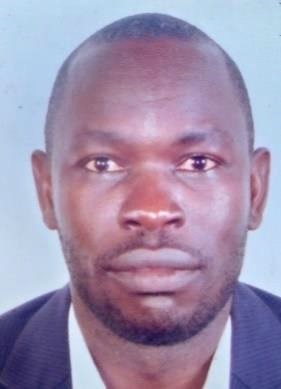
ENEKU John Paul
Optimization of the electrical resistivity of magnetron sputtered aluminium and boron co-doped zinc oxide thin films for solar cells.
Mr. ENEKU John Paul investigated co-doping of zinc oxide thin films with both aluminium and boron elements to develop a transparent thin film material of very low electrical resistivity for application as a transparent front electrode in thin film solar cells. This offers a low cost and eco-friendly alternative to the costly and toxic Indium Tin Oxide (ITO) electrode which currently dominates the solar cell market. The thin film based solar cells have the potential to significantly lower the price of photovoltaics based electricity. The investigation established that the co-doped zinc oxide thin film material can be used effectively as a transparent electrode in thin-film solar cells and can replace the costly standard Indium Tin Oxide (ITO). This study was funded by Makerere Universsity and International Science Program (ISP, Sweden) and supervised by Prof. Tom Otiti and Prof. Julius Mwabora.

BUTTIBWA Mary
Utilizing heated pollen and androgenesis pathways for the production of haploids in cassava
Ms. BUTTIBWA Mary investigated how heat-treatment of pollen facilitates production of haploids in cassava. Pollen, a fine powdery substance that comes from the male part of flowers and an equivalent of sperms animals, can be heat-inactivated and used hasten cassava embryo development. Because cassava’s reproduction cycle is too long it is difficult to quickly develop new varieties. The haploid technology can shorten this by 50%. Using heated pollen in pollination fostered the development of cassava embryos that further grew into haploid plants in a short time. The heated pollen germinated on the stigma but no fertilization was achieved; however, embryo development was stimulated. Early embryo rescue techniques rescued immature embryos on an artificial growth medium and re-generated into plants. This work contributes to the genetic improvement of cassava. The study was funded by the Bill and Melinda Gates Foundation through The International Centre for Tropical Agriculture and was supervised by Prof. Arthur Tugume and Dr. Robert Kawuki.

INUWA Badamasi
Effect of xenoestrogenic substances on fish health and reproductive potential of Nile tilapia, Nile perch and lungfish from two-distinctly polluted sites of Lake Victoria: the “more polluted”
Mr. INUWA Badamasi studied the effect of xenoestrogenic substances on fish health and reproductive potential of Nile tilapia, Nile perch and lungfish from two-distinctly polluted sites of Lake Victoria: the “more polluted” (Kasenyi, Ggaba, Port bell, Jinja) and the “less polluted” (Kasensero, Bale, and Bukakata). The motivation for this research was the decline in the wild fish stocks population of Lake Victoria, attributable to several factors, including pollution. Specifically, the study examined the liver conditions and gonadal development of fishes under different levels of pollution. Severe liver alterations were higher in fishes from more polluted compared to those from less polluted areas. Indeed, the chemical contamination of Lake Victoria could have caused the liver lesions and other changes in the fishes. Overtime, such chemical contamination could lead to negative impacts on the consumption of fish and fish products if actions are not taken to mitigate the risks. This study was funded by the Nigerian Federal Ministry of Education and supervised by Assoc Prof Charles Masembe and Dr. Robinson Odong.
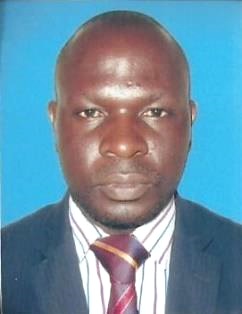
KITO Luliro Silas
The Numerical Range of Linear Relations and Stability Theorems.
Mr. KITO Luliro Silas studied the numerical range and stability theorems of linear maps on some mathematical spaces with the purpose of establishing the existence and uniqueness of solutions (solvability) to linear relation inclusions. In this study, he explored the effects of small alterations on certain maps between special spaces that are of mathematical interest in solving certain differential equations. The study found that within a certain degree of change, a small alteration on the map will not affect a particular set of characteristics of the map. These results are useful but not limited to; solving problems formulated when modelling airflow around an obstruction for example calculation of forces and moments on aircrafts, modelling fission weapon detonation, determination of mass flow rate of petroleum through pipelines, predicting weather patterns and ocean currents, solving fluid dynamics problems that require computation of fluid properties such as flow velocity, pressure, density and fluid temperature as functions of space and time. This study was funded by SIDA and was supervised by Assoc. Prof. Gerald Wanjala, Dr. Saul H. Nsubuga, Dr. Vincent. A. Ssembatya and Dr. Alex B. Tumwesigye.
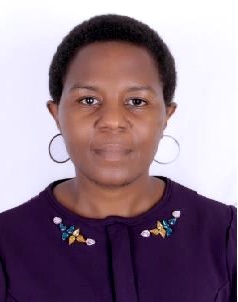
KYOMUHANGI Annet
Reduced Modules Relative to Functors
Ms. KYOMUHANGI Annet’s study focused on the description of reduced modules and their dual using functors. She introduced and studied properties of a functor that measures how far a module defined over a commutative ring is from being reduced. She also found a machinery that allows one to associate a nil ideal to every ring. Since reduced modules are dualisable, Annet studied properties of their dual known as coreduced modules. She further introduced functors that describe coreduced modules and studied their properties. Moreover, she found that reduced modules simplify computations of local cohomology while coreduced modules simplify computations of local homology. The study was funded by Makerere-Sida bilateral programme (2015-2020); Project 316: Capacity building in Mathematics and its applications. Ms. Kyomuhangi was supervised by Dr. David Ssevviiri and Dr. Alex Samuel Bamunoba, both from Makerere University.
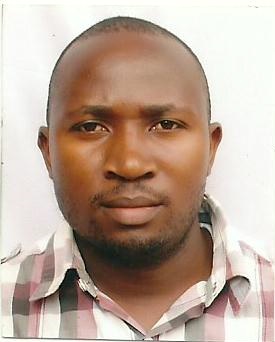
MAYANJA Edison
Mathematical Models for HIV-HCV Co-infection Dynamics under Various Control Strategies
Mr. MAYANJA Edison formulated mathematical models to study the dynamics of Human Immunodeficiency Virus (HIV) and Hepatitis C virus (HCV) co-infection. The HIV-HCV co- infection mathematical models which had been developed before, either ignored infection stages or considered HCV in only two stages of infection: the acute and chronic infection. However, the chronic stage of HCV is very long and consists of infected individuals that are asymptomatic yet infectious. Thus, this required deep analysis that had not been fully elucidated. In his study, he analysed the HCV chronic stage split it into: before onset of cirrhosis and its complications (Latent stage) and after onset of cirrhosis (Advanced stage). He used these mathematical models to investigate how HIV infection impacts the dynamics of HCV infection and vice versa. The study revealed that, increasing the rate of enrolment on HIV treatment reduces HCV prevalence and vice versa. Transmission probability per sexual contact and average number of sexual partners acquired per year were equally likely to result into increased HIV and HCV infections and these parameters were the most sensitive in increasing each of HIV and HCV infections. The study was funded by SIDA and was supervised by Prof. Livingstone S. Luboobi, Prof. Juma Kasozi, and Dr. Rebecca N. Nsubuga.
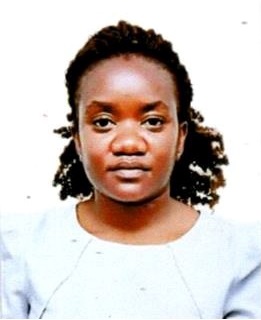
NABAWANDA Olivia
Flattened partitions: Pattern Avoidance and Behavior of Permutation Statistics.
Ms. NABAWANDA Olivia studied a sorting procedure (run-sort function) on permutations, where runs are rearranged in lexicographic order. The aim of the study was to investigate the behavior of the run-sort function with different permutation statistics namely runs, descents, peak-values and left-right minima. Olivia used Mathematica, a computation/mathematical software to generate the necessary data, which in turn she used in combination with bijective proofs and generating functions as the main tools. New combinatorial interpretations to several counting sequences namely A124324, Catalan, Fibonacci, Motzkin and Powers of two among others were provided as already indexed on the On-line Encyclopedia of Integer Sequences (OEIS) database, hence contributing to the existing body of knowledge. She also proved that the descent generating polynomials for these permutations are real rooted, and satisfy an interlacing property similar to that satisfied by the Eulerian polynomials, which are known to be real-rooted. Moreover, the run-sort function was found to possess interesting probability distribution properties. The research findings exhibited an interplay between discrete mathematics, probability theory and complex analysis. The study was funded by SIDA and supervised by Dr. Alex Samuel Bamunoba, Prof. Paul Vaderlind and Prof. Fanja Rakotondrajao of Antananarivo.

NALULE Rebecca Muhumuza
Hierarchical Models and Spatio-Temporal Processes In Data Analysis
Ms. NALULE Rebecca Muhumuza studied Hierarchical Models and Spatio-Temporal Processes in Data- Analysis with the aim of analyzing data which possesses both temporal and spatial dependence. She developed a non-linear general spatio-temporal model by extending Serfling’s model. Rebecca applied the theoretical findings to data of an outbreak of influenza in Southern Germany between 2001 and 2007. She also extended the random effect model by introducing the correlation coefficient between random effects in its definition. She again considered the problem of Bayesian estimation of heterogeneity parameter in the generalized random effects model where a comparison between the obtained results with the existing approaches was made. Rebecca used the findings for consensus building in meta-analyses of measurement results for the Newtonian constant of gravitation data and for the effectiveness of antiretroviral pre-exposure prophylaxis in preventing HIV infection. The study was funded by SIDA and was supervised by Prof Olha Bodnar, Dr. John Bosco Asiimwe and Dr. Rebecca N. Nsubuga.

NANFUKA Mary
The use of Splines for solving ill-posed problems, with application to the Cauchy problems for the Heat and Helmholtz equations
Ms. NANFUKA Mary developed a regularization procedure based on splines. The procedure was used to solve the Cauchy problems for the heat and Helmholtz equations, which are ill posed problems. The Cauchy problem for the heat equation had been previously solved by the Fourier transform method. The method, assumed that the time derivative, represented a periodic function which is not realistic. Thus, as an alternative, Mary approximated the time derivative by a cubic smoothing spline. The spline method effectively bounded the errors in the output solution according to the stability estimates. The Cauchy problem for the Helmholtz equation was regularized, by introducing a bounded approximation of the second derivative in the x-variable using cubic smoothing splines. A bound for the approximate
derivative was derived. The stability estimates, showed that the method worked pretty well and produced accurate results. The newly developed method was applied to an industrial setting for determining the surface temperature of steel and good results were achieved. The method is recommended for use for the solution to inverse problems that occur in the engineering and medical fields. The research was funded by Sida and supervised by Dr. Fredrik Berntsson, Dr.Godwin Kakuba and Assoc Prof. John Mango.

OCHEN William
Measurement and Modelling of Residual Stress in Porcelain Tiles Formulated from Different Quartz Particle Sizes in Uganda
Mr. OCHEN William studied residual stress in porcelain tiles formulated from different quartz particle sizes in Uganda. He measured residual stress using X-ray diffraction method, and modeling based on finite element method using abaqus software. His study was prompted by numerous complaints concerning the strength of the locally manufactured tiles. His study found out that residual stress decreases with an increase in quartz particle size over a range of 45-200μm. The decline in residual stress is attributed to the formation of cracks, which affects strength and hardness of the tiles. He further noted that upon sintering at 13000C, tiles with quartz particle size of 90μm exhibited properties that satisfied the ISO 13006 standard. His study therefore recommends the idea of fine quartz milling in a range of not more than 90μm. This study was funded by DAAD and supervised by Prof. Florence Mutonyi D’ujanga and Dr. Bosco Oruru.
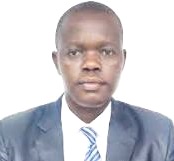
OKELLO Omwonylee Joseph
Limiting Behaviours of the Longest Gaps Between Occurrence Epochs in Poisson Processes.
Mr. OKELLO Omwonylee Joseph investigated the asymptotic properties of longest gaps between occurrence epochs in Poisson processes using the theory of large deviations, based on the laws of large numbers. To do this, the global estimation of the distribution functions of longest gaps was derived with the help of discretization argument and the Slivnyak’s formula of Palm theory. The derived global estimation was then used to achieve Laplace transform asymptotics of the longest gaps. Through the application of Fenchel-Legendre transform, it was found out that the longest gaps satisfy two large deviation principles with exponential and power rate functions. Since this study was about the probabilistic analysis of rare events, the results not only fill the literature gaps but also provide a very useful planning tool to insurance companies, risk analyst, department of disaster preparedness, operation managers and others. The study was funded by SIDA and was supervised by Dr. Xiangfeng Yang; Dr. Richard Awichi Opaka and Dr. Fred Mayabala.
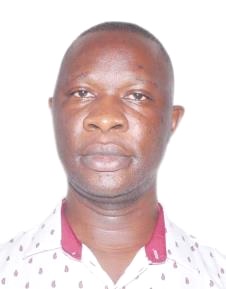
SSENYUNZI Richard Cliffe
Modelling Precipitable Water Vapour Using Global Navigation Satellite System Data over the East African Tropical Region.
Mr. SSENYUNZI Richard investigated the temporal and spatial variability of the zenith total delay and precipitable water vapour (PWV) data over the East African tropical region. The PWV data was collected from 13 geodetic permanent GNSS stations for the years 2013 to 2016. Lack of key variables such as the atmospheric water vapour, has been affecting the accuracy of weather predictions over the East African tropical region. The lack of this important parameter has been partly due to insufficient data and very scarce and unreliable tropospheric water vapour monitoring instruments in the region. In this study, the PWV, pressure and the weighted mean temperature linear models have been developed. The site-specific models developed can be utilized to supplement the GNSS and the weather stations data over the thirteen stations since they can provide estimates of nearly a similar degree of precision compared to the measured values. The study was funded by the African Development Bank and supervised by Prof. Florence Mutonyi D’ujanga and Dr. Bosco Oruru.
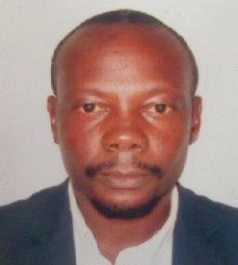
WAMONO Felix
Contributions to reduced rank regression modelling with applications to small area estimation.
Mr. WAMONO Felix studied the problem of decomposing residuals in the GMANOVA-MANOVA model with rank restrictions on parameters with applications in small area estimation. Firstly, Residuals in the GMANOVA-MANOVA model with rank restrictions on the mean parameters was considered. The main objective was to define residuals useful for evaluating the reduced rank restriction model. We decomposed linear spaces into four subspaces as it can be done for the Extended Growth Curve model with two “profiles”. The new residuals were defined by orthogonal projections on these subspaces. It was discussed how the new residuals could be used to test model assumptions. Secondly, Survey data from Uganda, including the 2014 Uganda Population and Housing Census data was analysed using small area estimation methodology. The GMANOVA-MANOVA model with rank restrictions on parameters was used to estimate the small area means. This study was funded by SIDA and was supervised by Prof. Dietrich von Rosen, Prof. Martin Singull, Assoc. Prof. Leonard Atuhaire and Dr. Innocent Ngaruye.
Browse Citations by College below:
< Director’s Message | CAES | CoBAMS | CoCIS | CEES | CEDAT | CHS | CHUSS | CoNAS | CoVAB | LAW | MUBS >
You may like
-
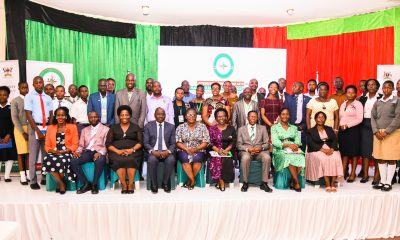

Mak develops new model to aid teaching of Maths in Lower Secondary Curriculum
-
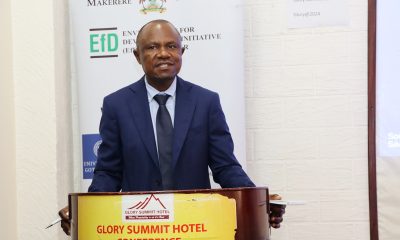

EfD-Uganda Holds Inaugural AGM: Celebrates Milestones and Outlines Future Plans
-
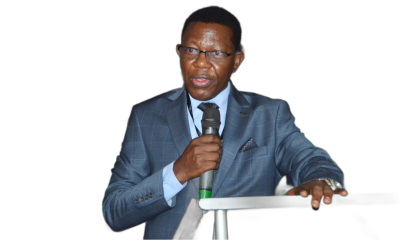

Prof. Buyinza Mukadasi Appointed Acting DVC Academic Affairs
-
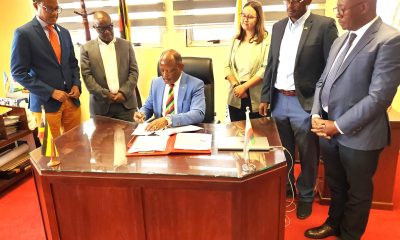

Mak, Oregon State University Sign Cooperation Agreement
-


Makerere signs MoU with EACOP Ltd.
-
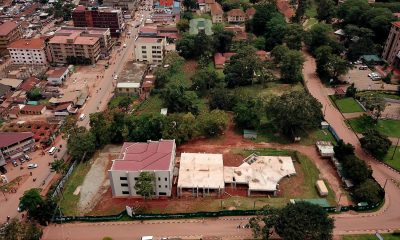

Digital Mobile Technologies to Study Tuberculosis: A Multi-Discplinary Program
Natural Sciences
CARTA Fellow Anywar Appointed Member of BMC Editorial Board
Published
3 weeks agoon
July 5, 2024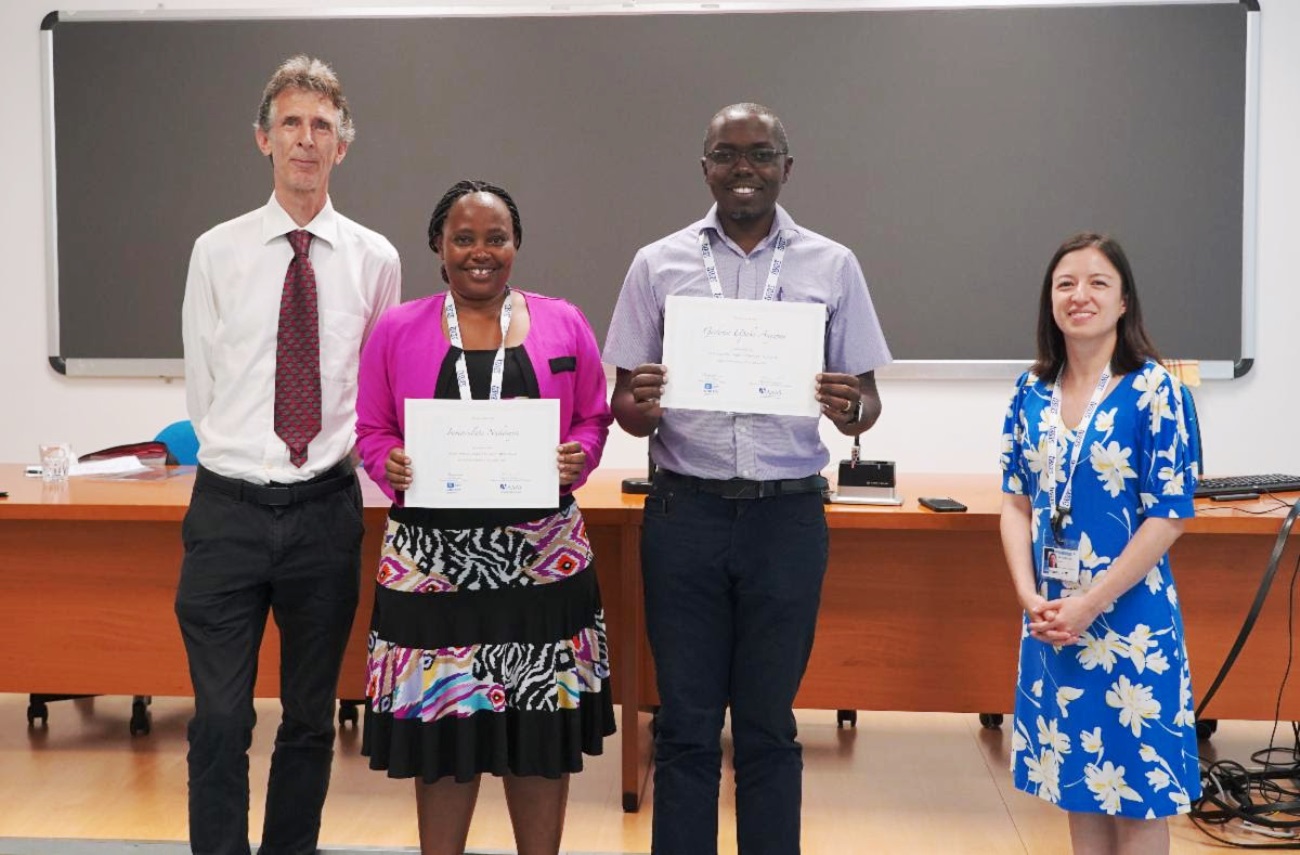
Godwin Anywar, cohort 6, Makerere University, was appointed a Member of the editorial board of BMC Complementary Medicine and Therapies on June 18, 2024. The appointment is on a rolling basis, renewable after every two years.
He also attended the Science Diplomacy Course in Trieste, Italy, from June 17 to 21, 2024, under the auspices of the American Association for the Advancement of Science (AAAS), Washington, DC, USA, and The World Academy of Sciences (TWAS), Trieste, Italy.
Source: CARTA Newsletter Issue 78
Natural Sciences
Mak Researchers develop Innovative Integrated Wetlands-bivalve system to Mitigate Effects of Pollution in Aquaculture farms in the Lake Victoria Basin
Published
4 weeks agoon
July 2, 2024By
Mak Editor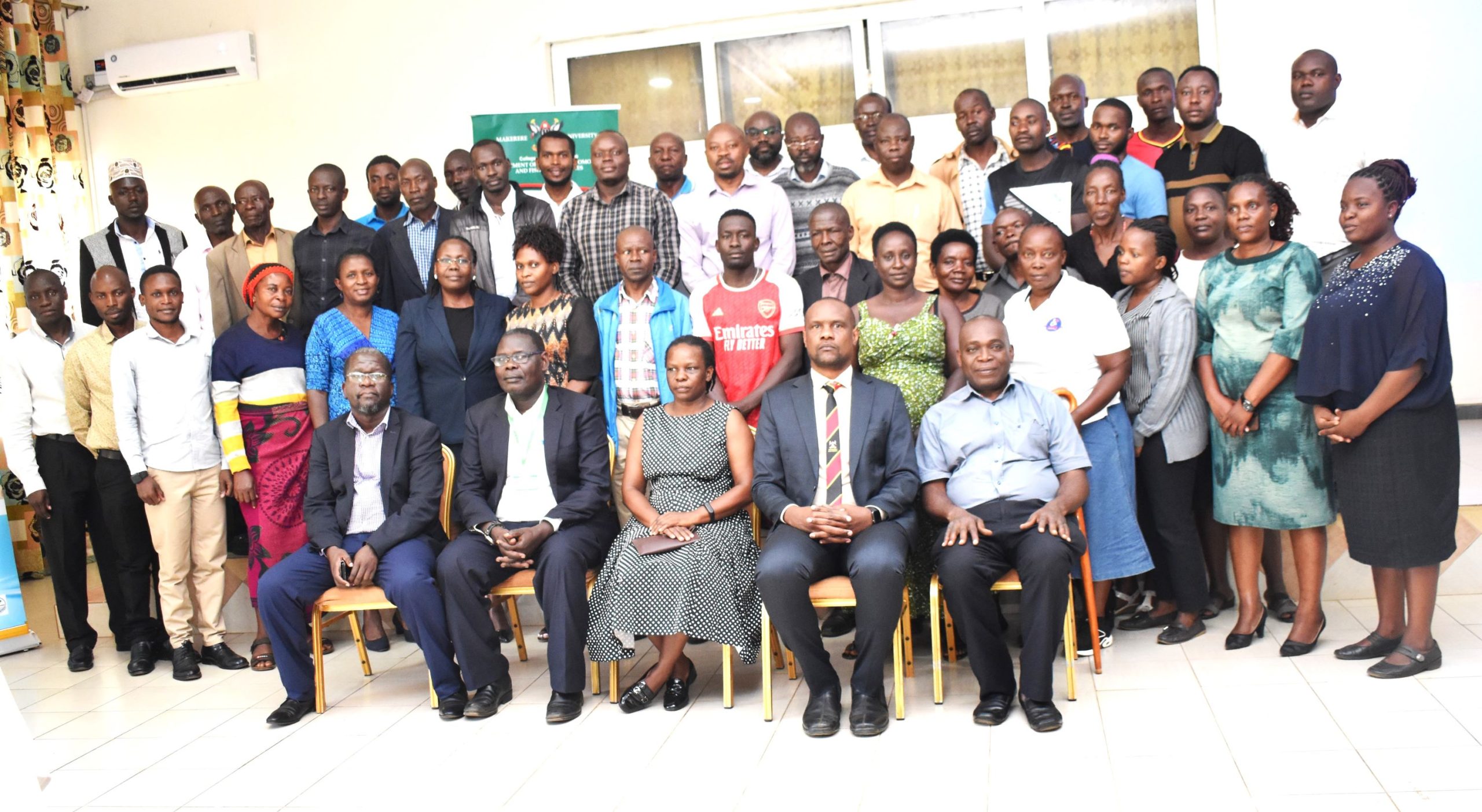
By Hasifa Kabejja & Dr. Robinson Odong
Overview
The fisheries sub-sector in Uganda is crucial, supporting over 5 million livelihoods and providing essential protein for up to 17 million people, with an average consumption of 10 kg per capita. Uganda’s population is projected to double in the next 27 years, prompting the National Development Plan III to aim for a significant increase in fish production, with aquaculture expected to contribute 1 million MT by 2030. The Fisheries and Aquaculture Act 2022 emphasizes adherence to National Environmental Management principles to achieve sustainable production systems.
However, as aquaculture grows, the sector faces environmental challenges due to increased intensive production and on-farm waste, including nutrients from feed, uneaten feed, poor quality feeds, pseudofeces, escaped farmed fish, and residual chemicals. These pollutants pose risks such as habitat quality deterioration, biodiversity loss, eutrophication of waterways, and the emergence of drug-resistant pathogens.
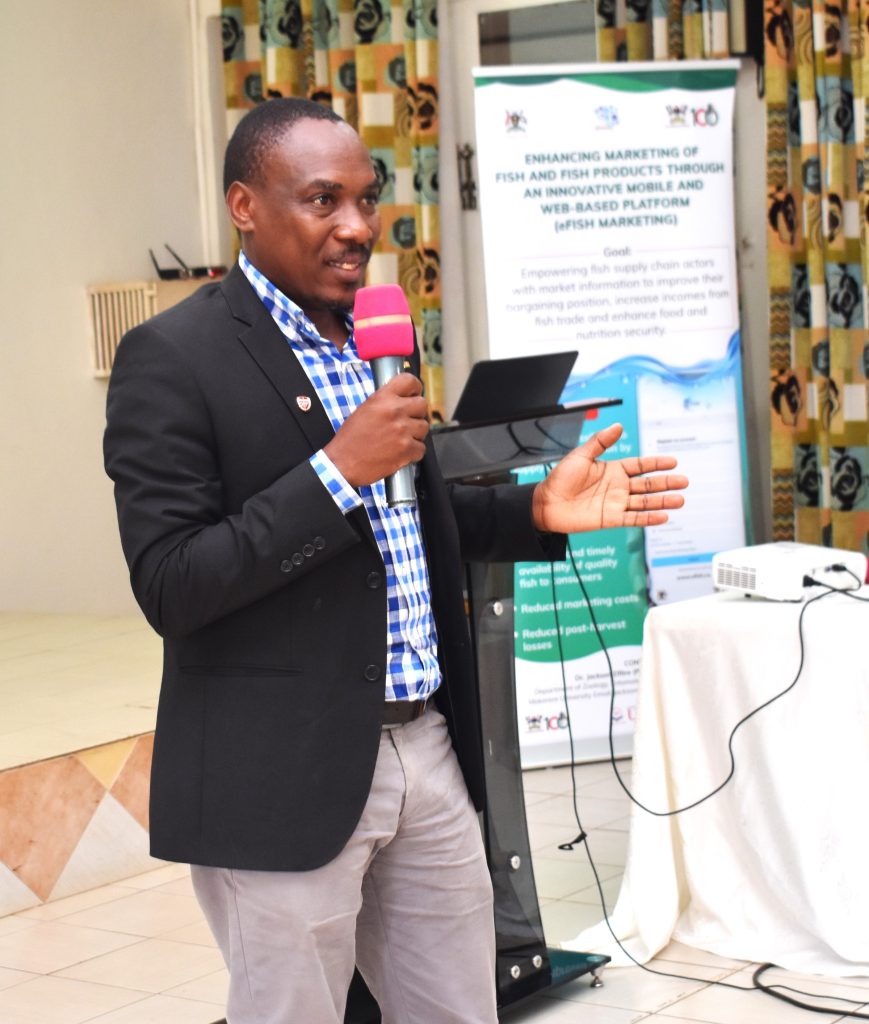
Mitigating the effects of environmental pollution from aquaculture
Through a Project titled: Mitigating the Effects of Environmental Pollution from aquaculture on freshwater resources in Lake Victoria Basin (MEEP), researchers from Makerere University in collaboration with the National Environment Management Authority (NEMA) set out to assess the effects of aquaculture facilities and practices on Lake Victoria, its catchment rivers and wetlands. The team led by Dr Ronald Semyalo from the Department of Zoology, Entomology and Fisheries Sciences (ZEFS) at Makerere University subsequently examined the effectiveness of innovative technologies, such as integrated wetland-bivalve systems, in mitigating these impacts. They also reviewed the application of national environment and aquaculture regulations in controlling environmental pollution. The study surveyed fish farms in three districts of Buikwe, Jinja, and Mukono within the Victoria Water Management Zone. Other project team members were: Dr Jerome Lugumira from NEMA, Dr Robinson Odong and Mr. Drake Ssempijja from ZEFS, Makerere University, and Ms. Ritah Namisango, Senior Public Relations Officer at Makerere. The Project was supported by the Government of Uganda through the Makerere University Research and Innovations Fund (MakRIF).

During their engagement with different stakeholders in the fishing industry including the fish farmers from Jinja, Buikwe and Mukono, as well as experts from the Directorate of Water Resources at the Ministry of Water and Environment, NEMA, and the Directorate of Aquaculture Development at MAAF, the research team established that only 138 out of 380 registered fish farms were active, with 45.6% of the farms in Jinja, 35.5% in Mukono; and 18.8% in Buikwe. Overall, over 60% of the farms were inactive posing serious environmental threats.
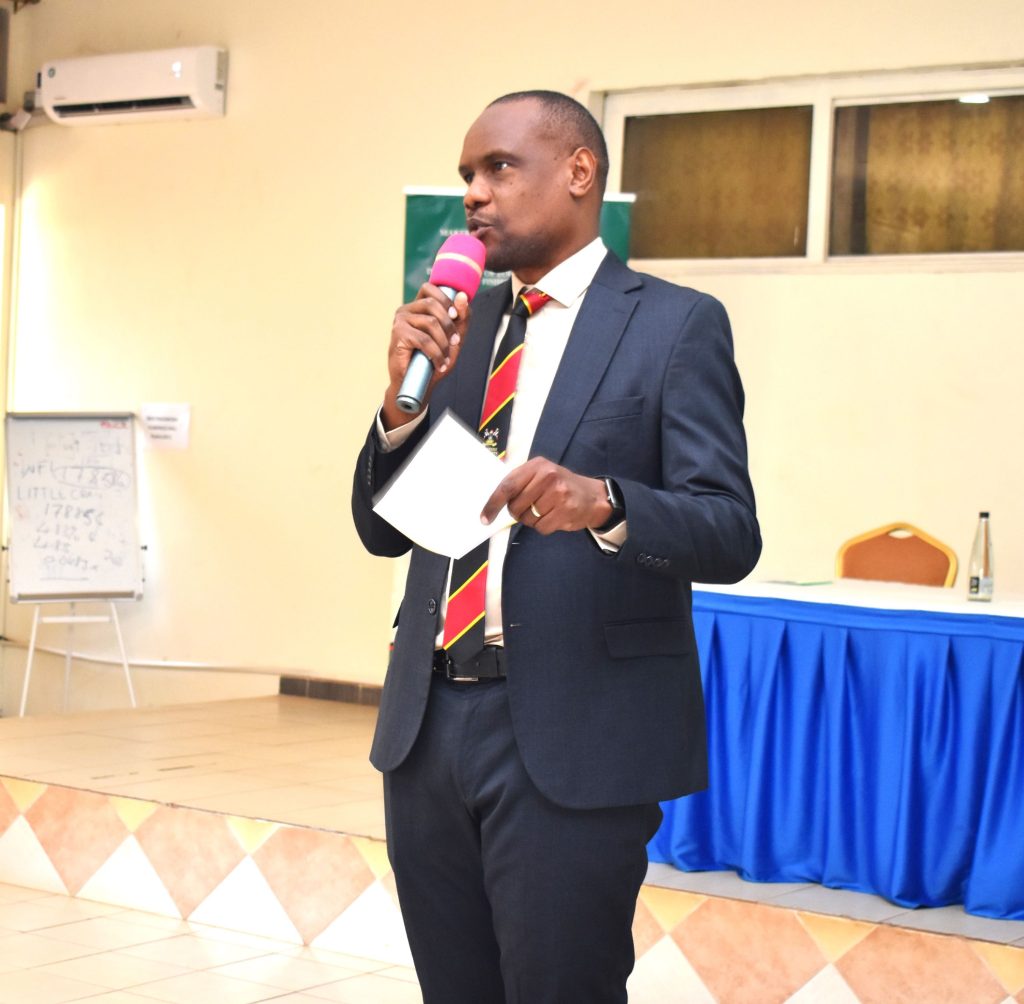
Dissemination of the research findings
On 26th June 2024, the project team held a workshop at Colline Hotel Mukono to disseminate the research finding to stakeholders who included fish farmers from Buikwe, Jinja and Mukono, District Fisheries Officers, as well as representatives from NEMA and MAAIF. In the presentations, the team highlighted the environmental impacts of aquaculture practices and the possibility of innovatively using nature-based, environmentally friendly innovations as a mitigation measure. The presentations covered farm characteristics, water and feed management practices, water quality assessments and waste management methods. The participants engaged in discussion on the implications of the results and shared their experiences and challenges in managing aquaculture operations.
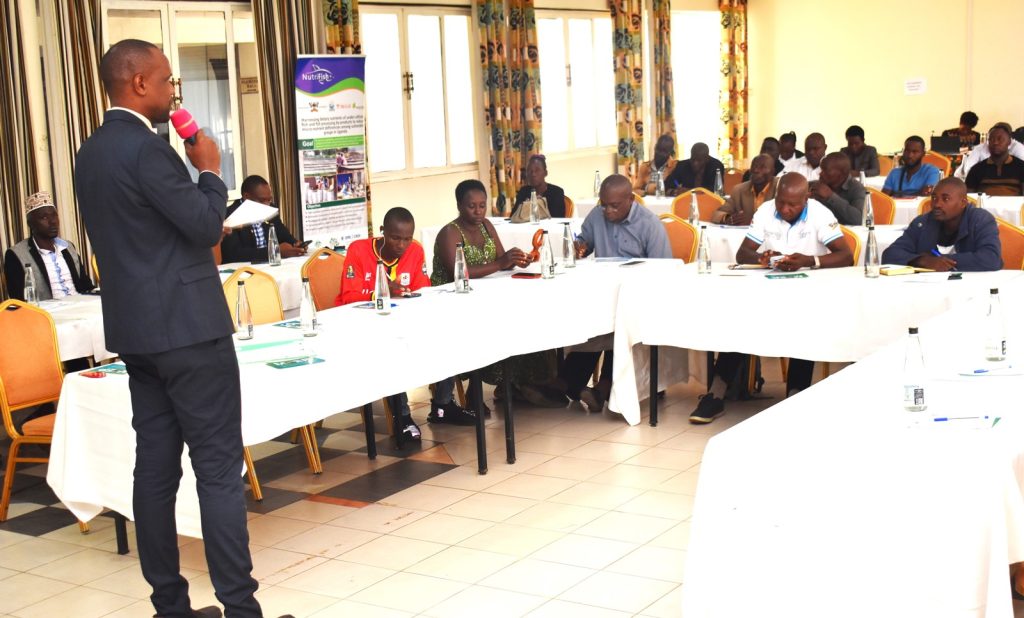
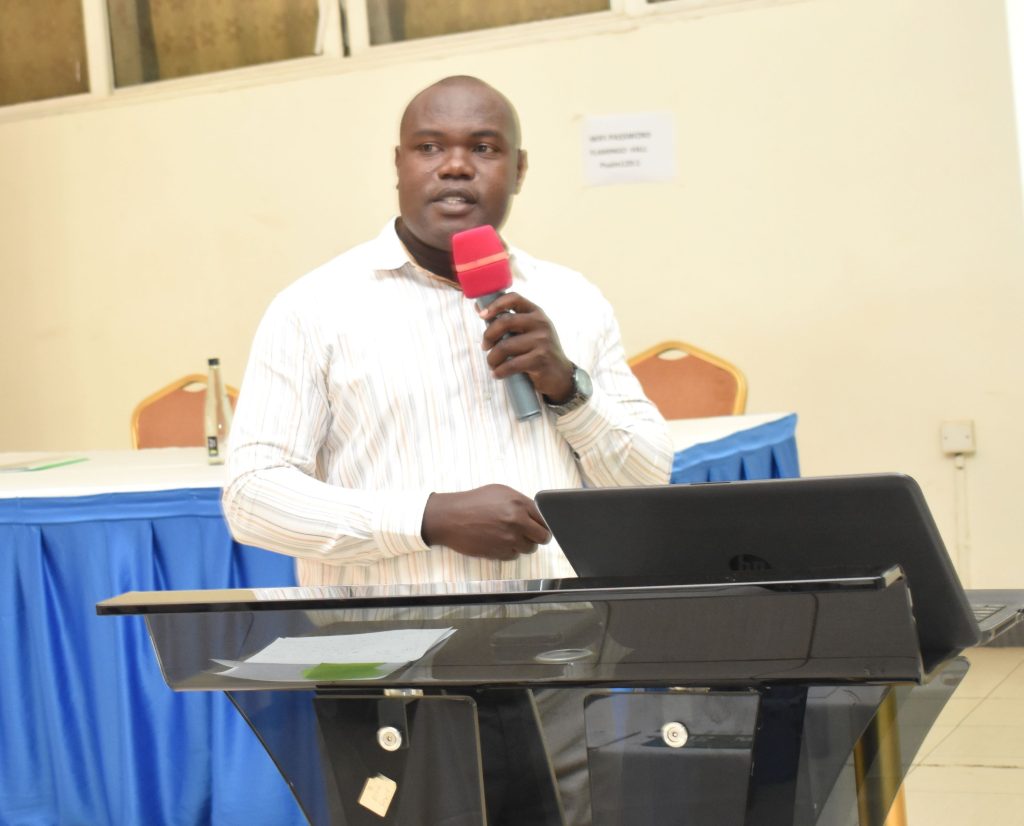
Key findings as disseminated by the PI
Out of the 380 farms, 119 were assessed. Below are the key findings;
- Environmental Impact Assessment: It was established that 81% of the farmers had not conducted Environmental Impact Assessments (EIAs) and Environmental audits. This, the researchers noted was one of the major causes of abandoned farms.
- Farm Characteristics: The majority of farms used earthen ponds (66.9%) and were semi-intensive (63.6%), relying on manufactured feed and pond fertilization. Intensive farms (30.5%) exclusively used manufactured feeds, while extensive farms (4.2%) relied solely on pond fertilization.
- Fish Species: Nile tilapia was the top choice (96.1%) for monoculture farms, while tilapia and catfish were preferred for polyculture systems (46.9%). Intensive farms predominantly farmed Nile tilapia.
- Demographics: Most respondents were male (90.7%), with a median age of 35 years. The largest age group was 31 to 59 years (43.2%).
- Fish diseases: The research revealed a number of diseases affecting aquaculture including: lesions/wounds on the belly and cysts on the scales, skin lesions and cysts on the belly, popping eyes and white substance on fins, open skin wounds, open wounds on the head, skin lesions – greyish, swollen eyes, whitish and black patches on the skin on the pelvic fin, wounds on the head.
- Water Use: Fish farms primarily relied on spring water and lake water. Other sources, such as streams, wells, and rivers, were also utilized. In most cases, the water source was shared with the community. Only a small percentage of respondents acknowledged any known disease outbreaks on their farms. There was a strong association between the district in which the farm was located and the water source used. Majority of those using lake water were in Jinja District, while most of those using spring water were in Mukono District. Additionally, there was a significant association between the fish species cultured and the water source used.
- Feed Management: A significant proportion of the farms heavily relied on factory-made feeds. These feeds were often used in combination with farm feed materials, such as maize bran, potato vines, yam leaves, and kitchen waste. A smaller number of farmers exclusively relied on farm-made feeds, while an even smaller percentage solely relied on pond fertilization. Manufactured feeds were used in various forms: powder and floating pellets, powder, crumble, and floating pellets, powder only, floating pellets only, and sinking pellets. The most prevalent method of feed delivery was feeding by response, while some farms also practiced feeding by ration.
- Waste Management: The findings indicated a concerning lack of treatment for aquaculture effluent, with majority of respondents (69%) releasing it directly into natural streams or wetlands. This highlights the need for improved environmental management practices. Common waste sources included faecal matter and dead fish. Most farms incinerated or buried solid waste.
- Water Quality: Measurements at the representative visited farms showed compliance with FAO optimal conditions for fish farms. The physicochemical parameters of the farms visited were in line with FAO optimal conditions for fish farms.
- Prevailing Regulatory System: A comprehensive gap analysis was conducted to supplement the findings from the survey. It aimed to identify weaknesses and areas for improvement in current policies and regulations governing aquaculture. It also evaluated the effectiveness of existing measures in addressing environmental pollution, waste management, and sustainable water use. This exercise provided a foundation for developing more robust and effective regulatory frameworks that support sustainable aquaculture practices, protect water resources, and enhance the overall environmental health of the Lake Victoria basin.
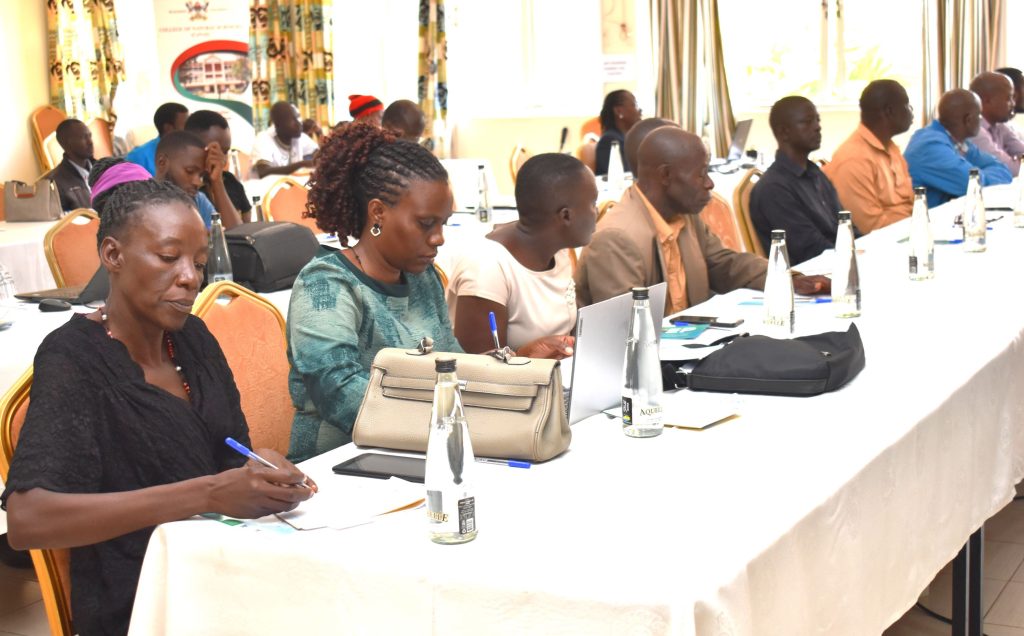
Project output
***Innovative Integrated wetlands-bivalves system was developed to mitigate the impact of pollution emanating from aquaculture on the environment
Effluent from poor aquaculture practices may contain uneaten feed residues and associated components, such as suspended solids, nutrient nitrogen and phosphorus and organic materials. If discharged without any form of treatment, such effluent contributes to excessive nutrient enrichment of water bodies, a phenomenon referred to as eutrophication. Eutrophic waters have diminished ecological value, for example are low in oxygen level and can lead to fish kills. Wetland plants, such as duckweeds can aid in cleansing of aquaculture effluent of excess pollutants, through various mechanisms. For example, the plant roots adsorb suspended solids, besides offering conducive attachment surfaces for beneficial microorganisms which perform various nutrient recycling roles. The plants also uptake excess nutrients, hence reducing their levels in water. Bivalves (Molluscs) are filter feeders, hence uptake and cleanse water of detrital or solid materials, hence augmenting the roles of the plants. The integration of wetlands-bivalves system offer synergistic roles in aquaculture effluent treatment. The plants and bivalves used in the treatment can in turn be removed and used for other beneficial purposes.
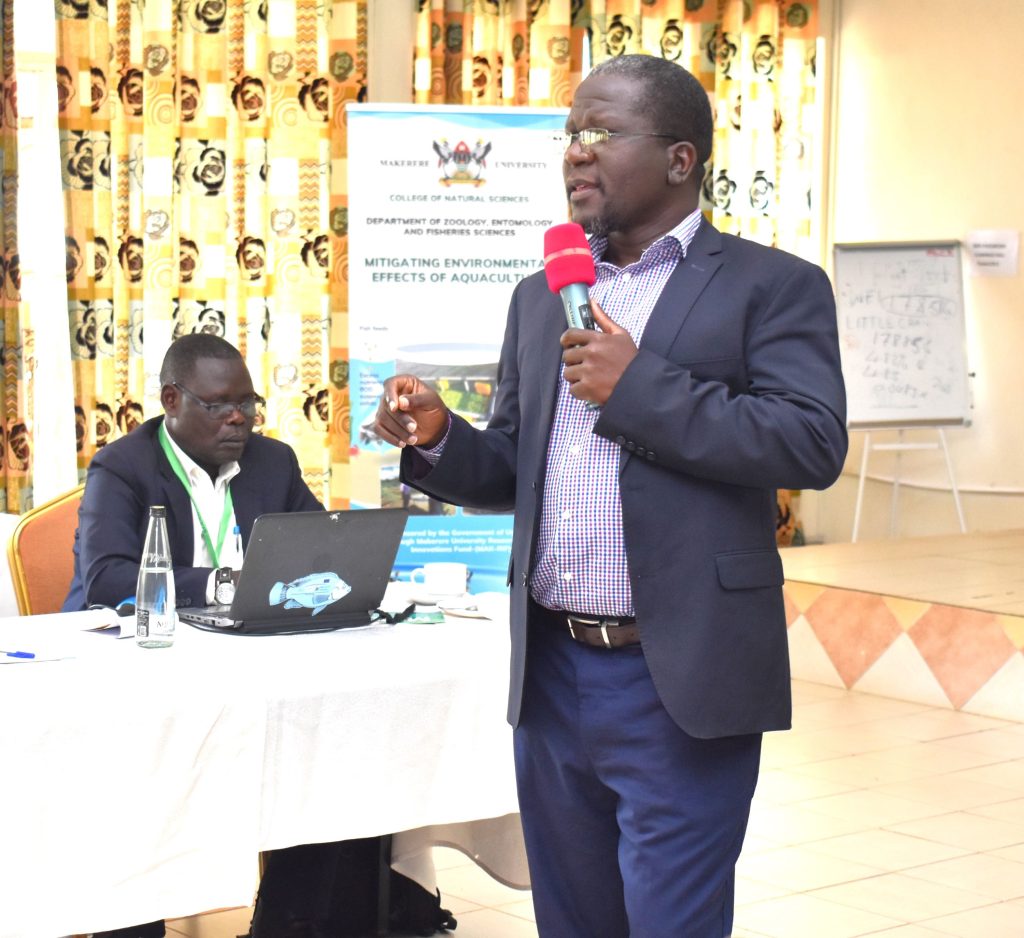
Presentation on policy gaps
During the dissemination workshop, Dr Jerome Lugumira, the Natural Resources Manager, Soils and Land Use at NEMA sensitized participants on the National Environment Act, 2019 with special emphasis on policy regulations for the aquaculture sector. He emphasized the need to acquire an EIA certificate before engaging in aquaculture. Highlighting the gaps in policy, Dr Lugumira noted that Schedule 4 of the National Environment Act, 2019 does not sufficiently guide the Fisheries sector; while the Physical Planning Act, 2010 is biased towards physical development planning, and the Water Act, 1997 provides for a waste discharge permit but no consideration of the extent of wastes discharged from fish farms of varying size and intensity is provided.
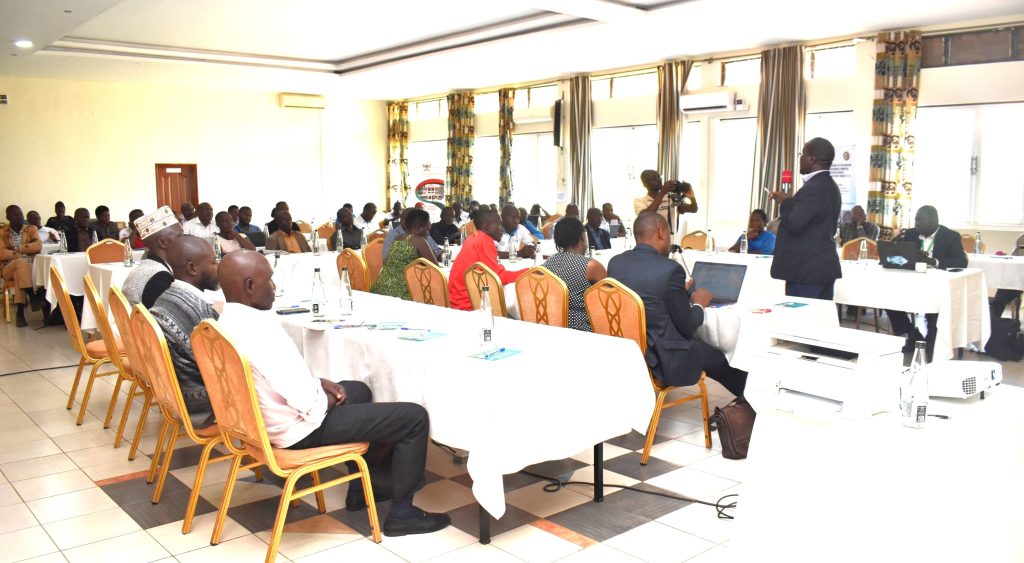
He further noted that the National Environment (Wetlands, Riverbanks and Lakeshores Management) Regulations, 2000 do not guide on areas where aquaculture best fits, indicating that the application of the 25% wetland area beyond which one needs approval is vague.
Additionally, he explained that the National Environment (Waste Management) Regulations, 2020 refer to fish waste generally and not whether it means waste from fish or all waste from fish farms, such as off-cuts, unwanted materials, and that the National Environment (Standards for Discharge of Effluent into Water or Land) Regulations, 2020 consider effluent discharge and not that released in-situ and that disposed directly into water via cages and into soil via land-based systems.
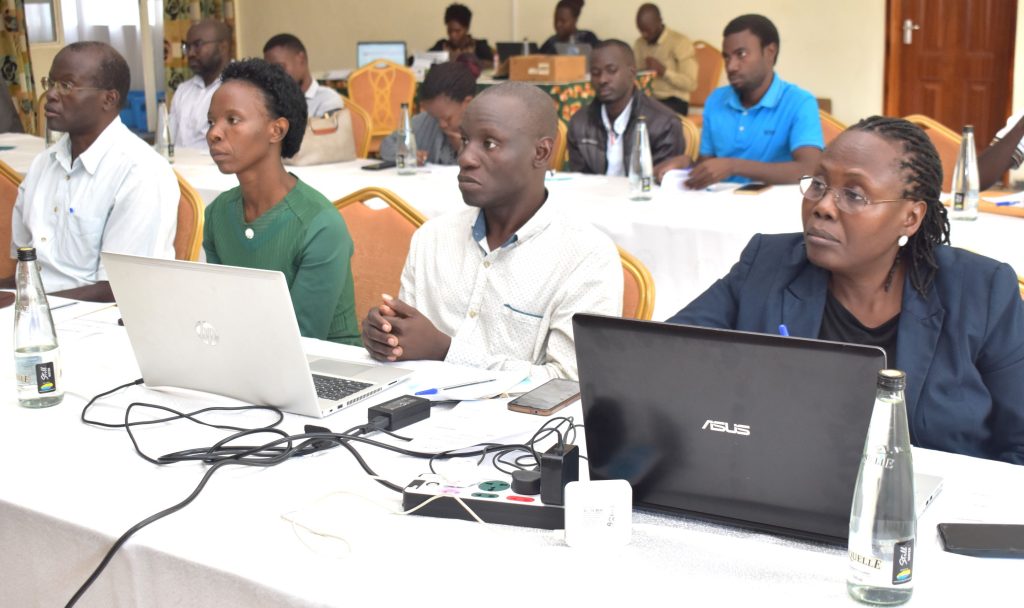
Dr Lugumira called for the review of the National Environment (Wetlands, Riverbanks and Lakeshores Management) Regulations, 2000, by requiring the mandated Lead Agency (WMD) to issue approvals for access to wetlands, and appending guidance on wetlands and lake areas where aquaculture is suitable. He suggested that submissions seeking approval from NEMA should have all required approvals from MAAIF, WMD and DLGs. “The assessment process should be supported by a technical officer skilled in fisheries sciences and not generalists,” he noted.
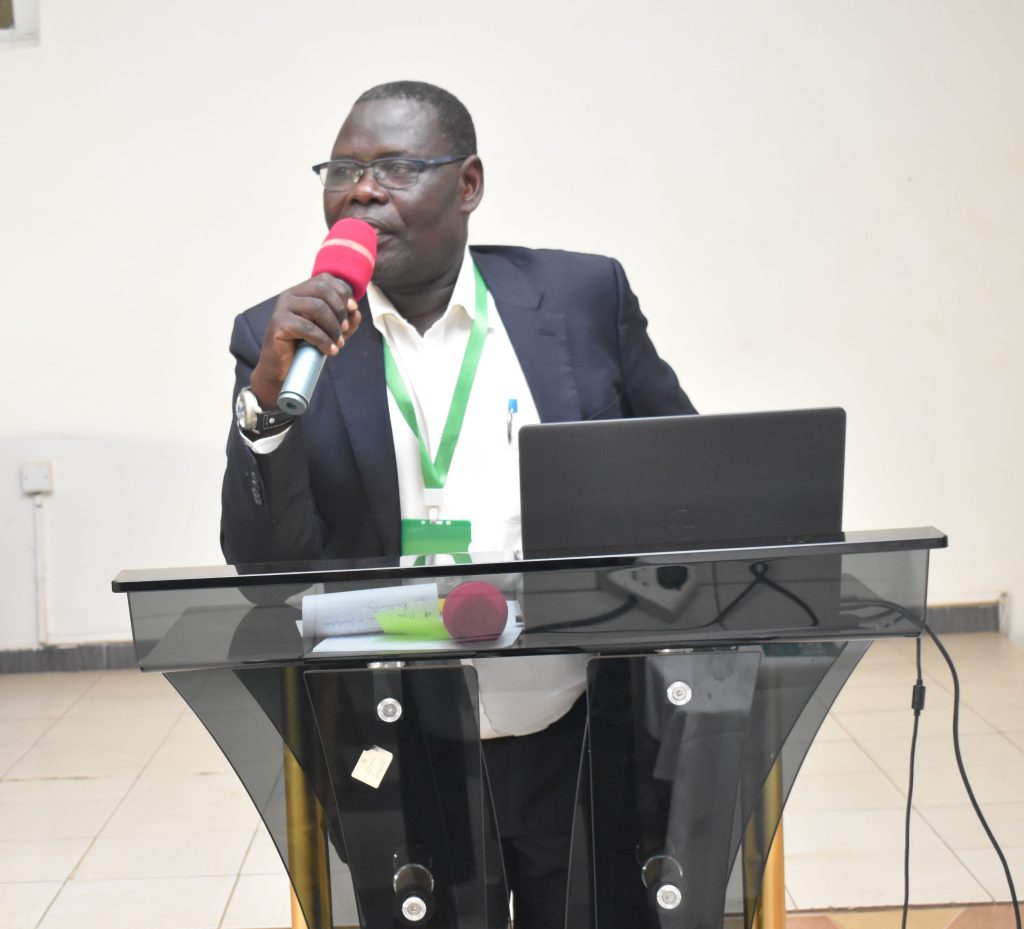
Overview on the state of capture fisheries and aquaculture in Uganda
Sharing an overview on the state of capture fisheries and aquaculture in Uganda, Mr. Geoffrey Dheyongera, Principal Fisheries Officer at MAAIF, noted that the global decline/stagnation in capture fisheries stocks had increased demand for fish, calling for a boost in fish production through stock enhancement in water bodies and promotion of aquaculture. “There is need for huge investment in aquaculture. The Aquaculture Policy targets 1 million MT from aquaculture through establishment of aquaparks with intensive management activities.”
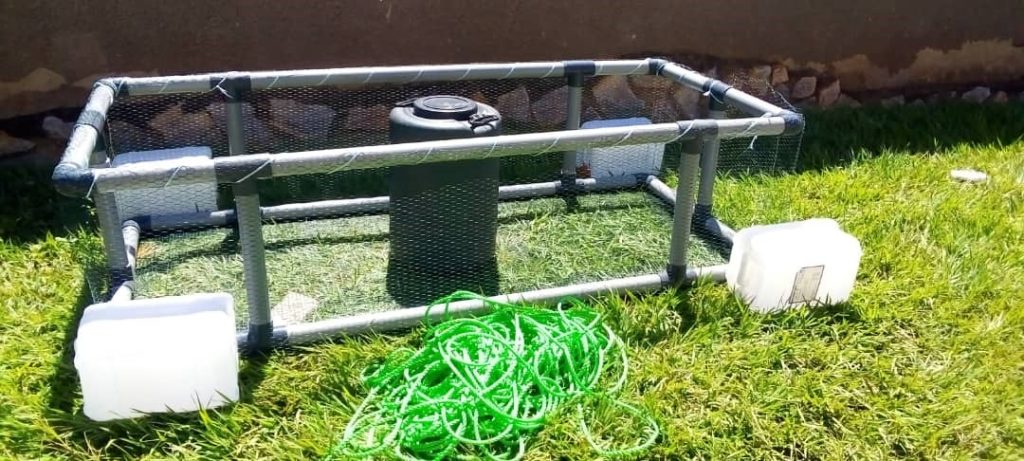
Key concerns raised by the farmers
During the focused group discussions, participants highlighted a number of factors undermining the growth of the aquaculture sector. These include;
- Ignorance about the laws/policy guidelines
- Low skills and lack of exposure in aquaculture management
- Low numbers of technical staff to guide the farmers
- Inexperienced technical staff
- Cheating by fish seed producers
- Expensive and poor quality feeds
- Fluctuating prices of fish
- Competition with capture fisheries/negative attitude towards farmed fish
- Increased degradation of the environment which affects water quality
- High interest rates on loans
- Farmers fear for exorbitant taxes
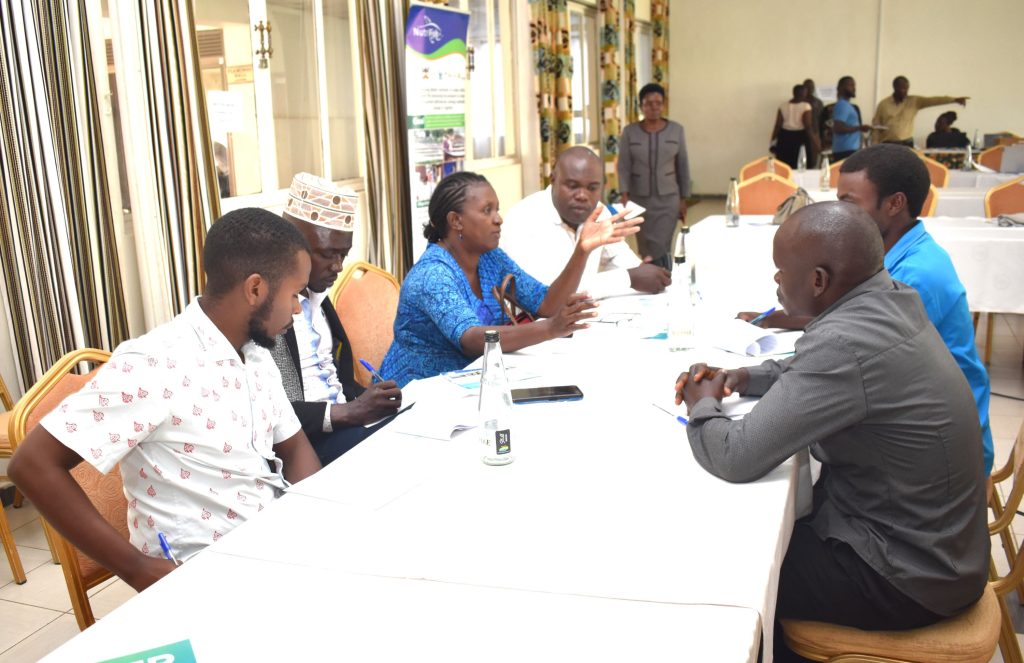
Proposals for improvement
- Government should recruit technical staff to assist farmers
- Thorough training of extension staff
- Encourage value addition to farmed fish
- Integrate climate smart interventions in aquaculture
- Policies regulating the sector should be popularized
- Undertake periodical review of the existing policies
- Encourage multi-stakeholder involvement in the implementation of policies
- Invest in research responsive to fish and aquaculture sector needs
- Monitor quality of fish feeds to satisfy farmers’ needs and environmental safety
- Private hatchery operators must be supported by the responsible sector agencies to ensure quality seed. Likewise, fish seed must come from certified hatcheries.
- Inspection of farms should be strengthened
- Train farmers on proper aquaculture management practices
- Farmers should work in groups to reduce production costs, negotiate better prices for their products, access credit facilities and maximize profits
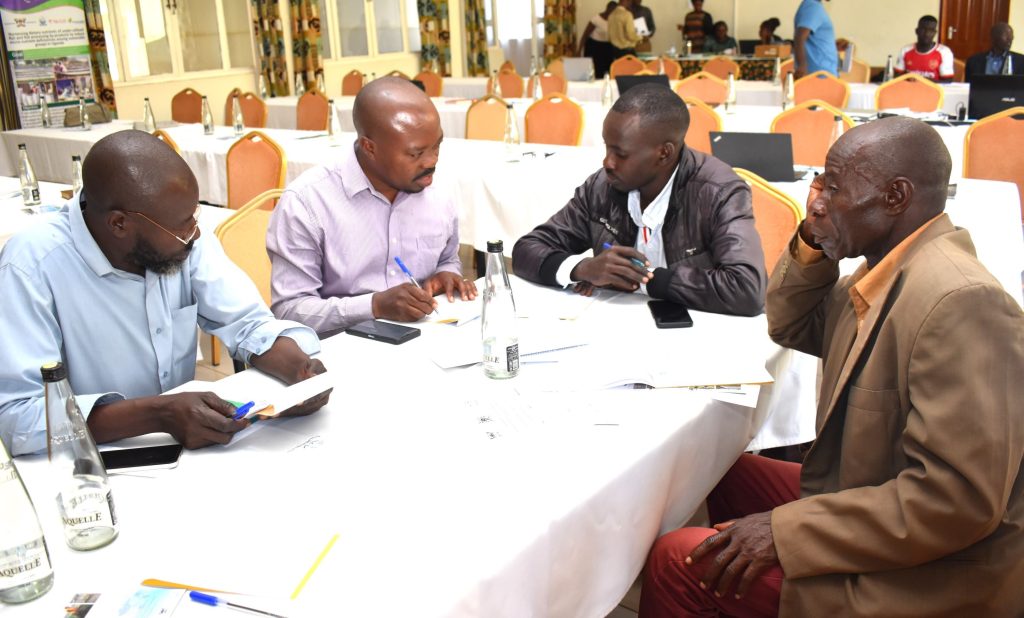
Remarks by the Guest of Honour, Mukono District CAO, and the Principal, CoNAS
In his remarks, the Guest of Honour, also Assistant Commissioner Aquaculture Management at MAAIF, Mr. Alio Andrew, guided the farmers on proper aquaculture practices, and encouraged Ugandans to invest in the fish sector. “The demand for fish has increased. Aquaculture remains a viable option,” he noted. He also raised the need to support private hatchery operators to produce quality seed, emphasizing that fish seed should only be bought from certified hatcheries. He highlighted the significance of biosecurity in aquaculture, and the need to collect appropriate data on the sector.
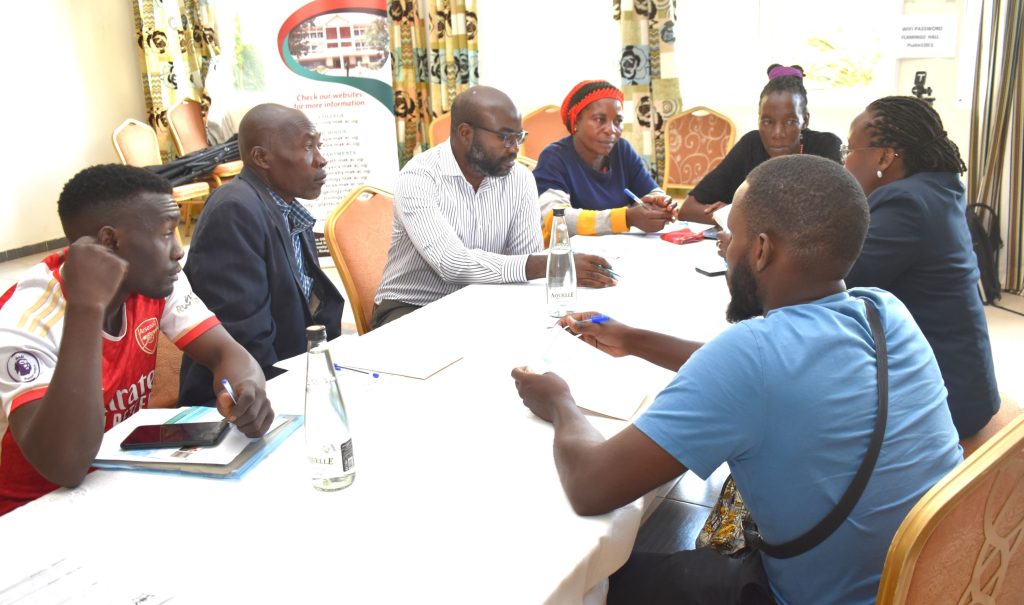
The CAO Mukono District called for intensified training of farmers in aquaculture management practices. She advised the farmers to work in groups if they are to make reasonable profits.
The Principal, College of Natural Sciences (CoNAS), Makerere University, Prof. Winston Tumps Ireeta, acknowledged the involvement of the community in research, and appreciated the fish farmers for actively participating in the project activities. He expressed gratitude to the Government of Uganda for the continued support towards research at Makerere University. Besides other initiatives geared towards improving research at Makerere, the Government is supporting over 700 research projects at Makerere through the Research and Innovations Fund. He also appreciated MAAIF and NEMA for the technical guidance extended towards the project.
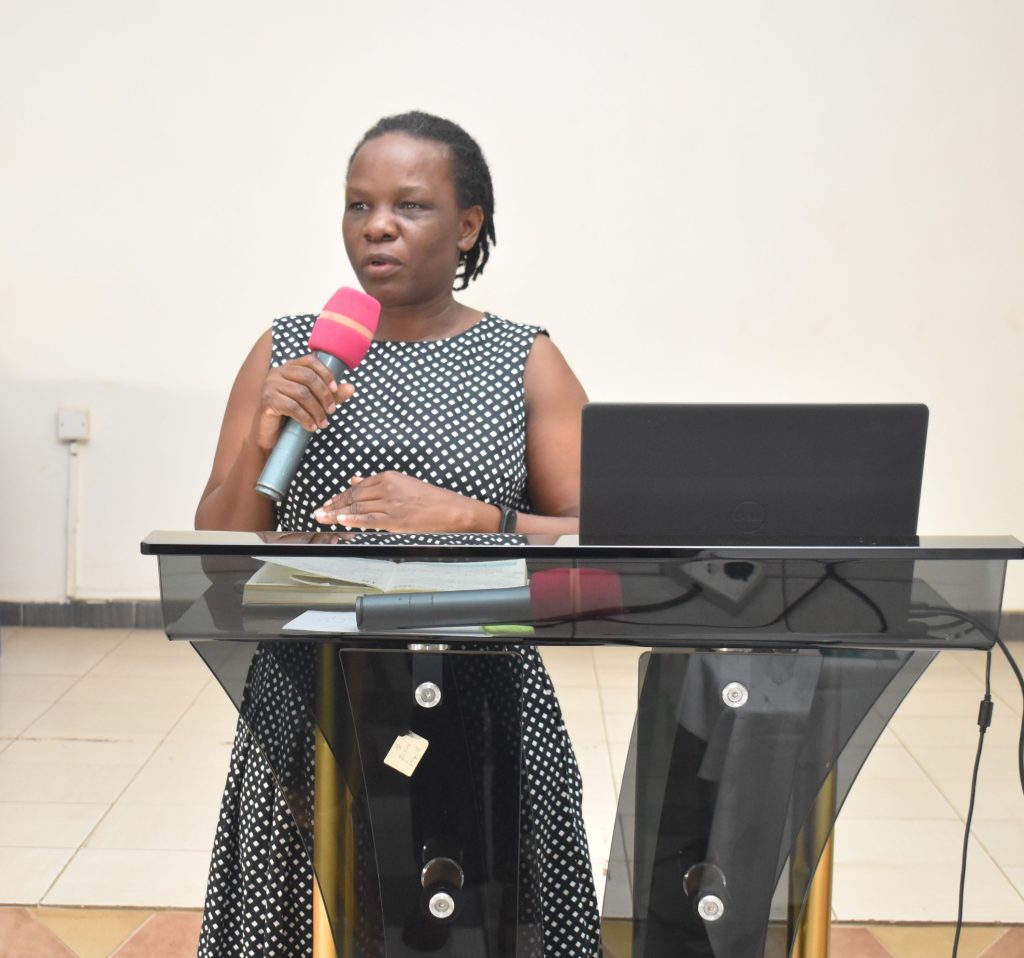
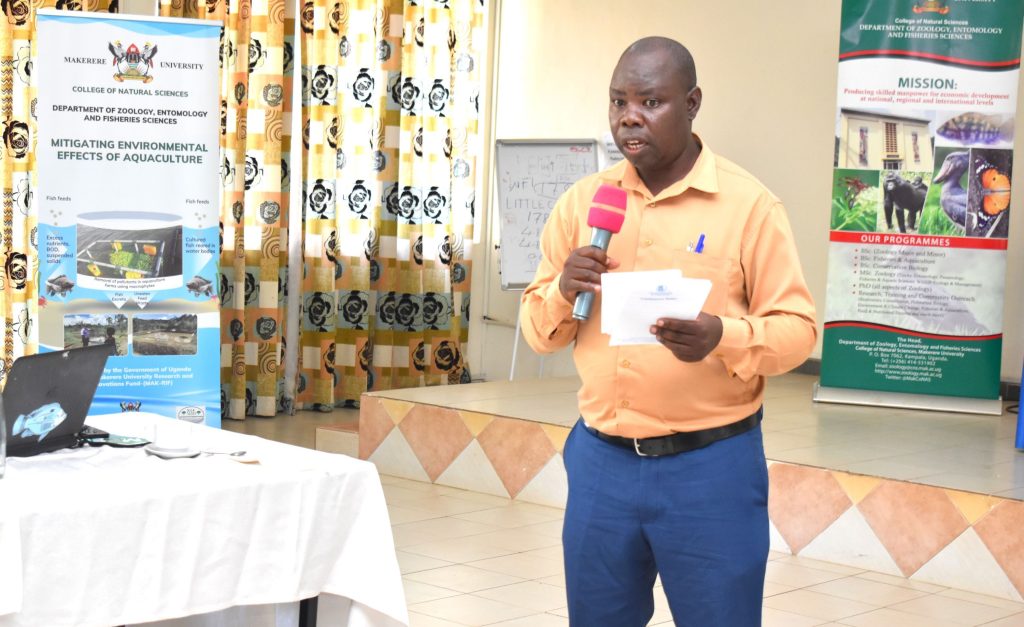
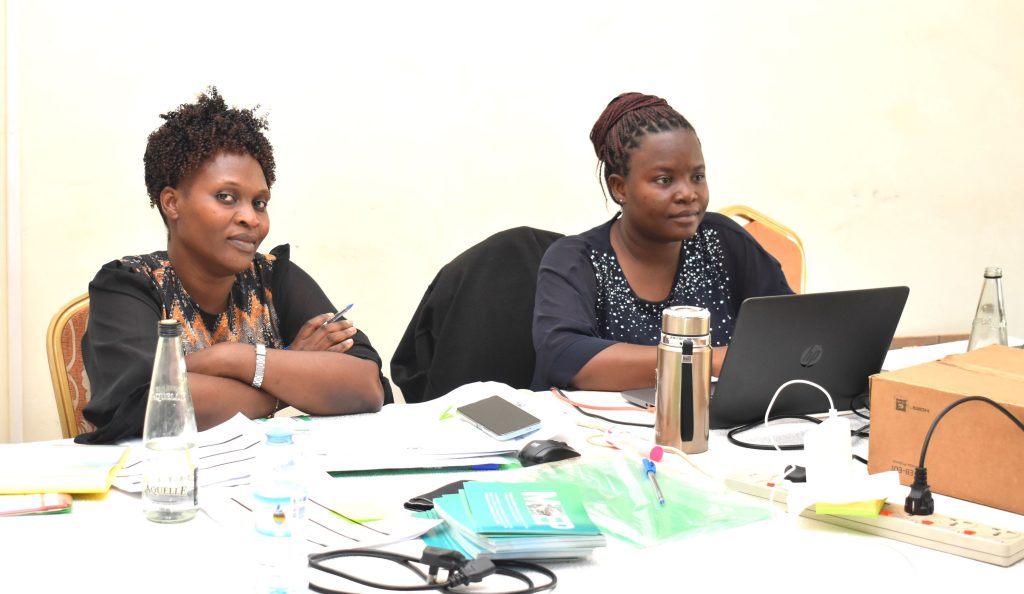
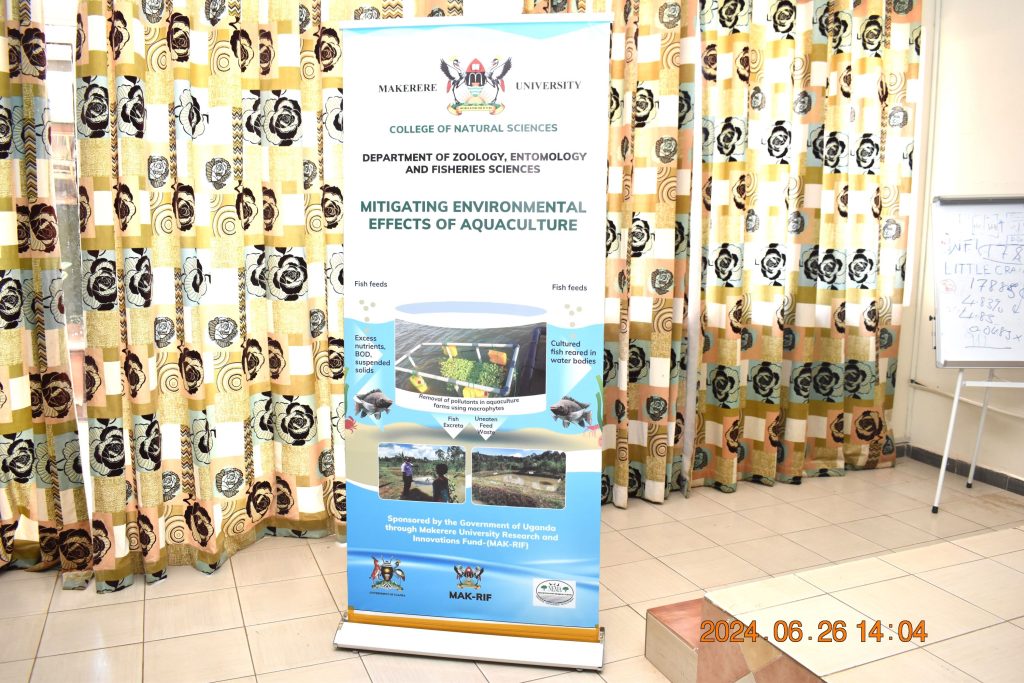
Natural Sciences
Call For Applications For Masters Scholarship Under The Biosorption For Sustainable Small-Scale Gold Mining In Uganda (BioGold) Project
Published
2 months agoon
June 5, 2024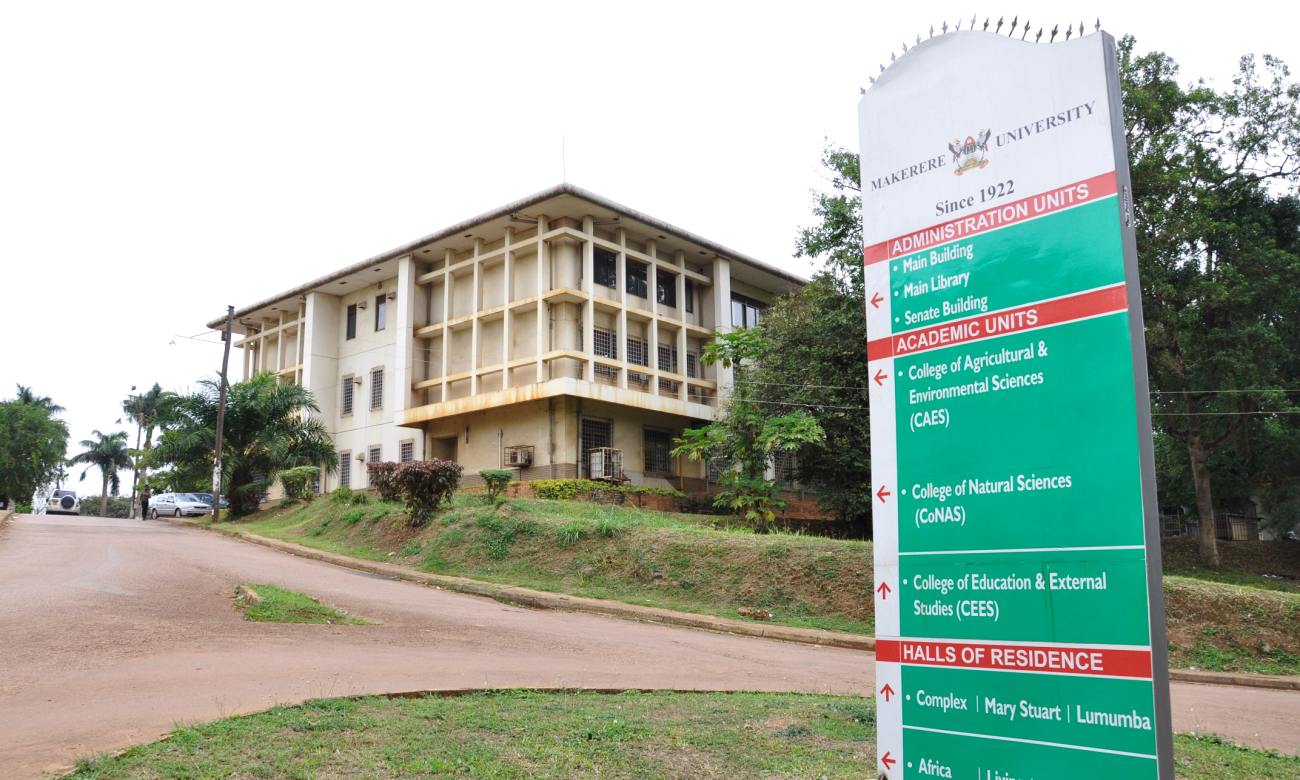
BioGold Project is a three-year collaborative project among five academic institutions including, Kyambogo University, Makerere University, Gulu University, University of Pretoria and University of Continuing Education, Krems, Austria funded by the Austrian Development Cooperation under the APPEAR Partnership. The project will combine principles of biosorption and chemical remediation to treat contaminated wastewater, tailings, rehabilitate contaminated soils so as to protect vulnerable ecosystems surrounding artisanal gold mining (ASGM) areas in Uganda. This study will design biochar composites from locally available biomass to enhance mercury removal from wastewater and tailings as well as rehabilitate mercury-contaminated soils making them fit for agriculture. The project envisages to train and build capacity of young researchers in Uganda. As such the project has been allocated an MSc. position under Component II, to support to full-time student to undertake studies in Austria. The successful MSc candidate is expected to undertake research on characterizing, optimizing biochar and modify the biochar to improve the sorption capacities.
The project consortium is now inviting qualified and interested persons to apply for nomination for the award of the scholarship. The project has strong preference for female candidates, therefore strongly encouraged to apply.
Eligibility criteria
In addition to APPEAR requirements https://appear.at/en/implementation/embedded-scholarship-application, the applicants should:
- Not be older than 30 years (women not older than 35)
- Demonstrate interest and capability to work in the priority themes
- Present a concept note to provide understanding of the subject
- Have a minimum of second- upper class bachelor’s degree in any of the following programmes: BSc in Chemistry, BSc in Environmental Science, & BSc in Environmental Engineering
Benefits
The successful applicants will receive a full scholarship (up to 24 months) which includes;
- Return air ticket and visa costs to Austria
- Monthly stipend of €1000 while in Austria to cater for personal welfare, accommodation and local movement
- Research related expenses.
Application process
- A complete application form
- A one-page motivation letter
- Curriculum vitae (maximum 2 pages)
- A completed Master Scholarship Application Form for Embedded APPEAR Projects
- Copies of Academic documents
- Photocopy of the passport and/or ID
- Recommendation letters from two academic referees.
- All applications must be sent electronically to Dr. Mary Kaggwa (marykaggwa@kyu.ac.ug) and copied to Dr. Peter Akoll (peter.akoll@mak.ac.ug) and Dr. Denis Nono (d.nono@gu.ac.ug) not later than 5.00pm East African Time on 20th June 2024.
Members of staff with former students interested in biochar technology and its use in heavy metal removal are requested to share the advert with them.
Full Advert and Application form may be accessed below.
Note: Only successful applicants will be contacted.
Trending
-
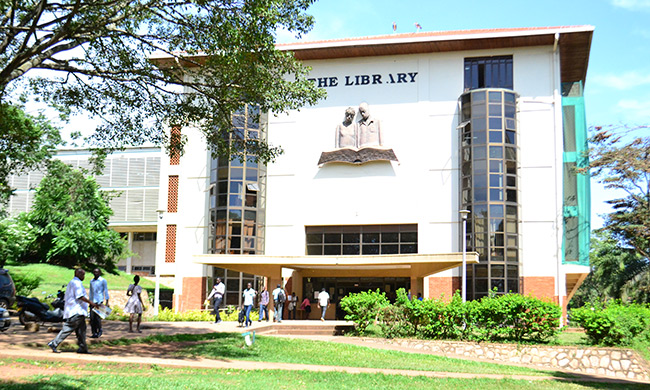
 General1 week ago
General1 week agoDiploma/Degree Holders Admission Lists 2024/25
-
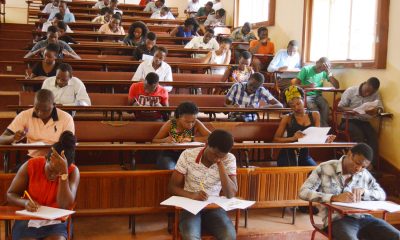
 General1 week ago
General1 week agoAdvert: Mature Age Entry Scheme – Private Sponsorship 2024/2025
-

 General5 days ago
General5 days agoProf. Buyinza Mukadasi Appointed Acting DVC Academic Affairs
-
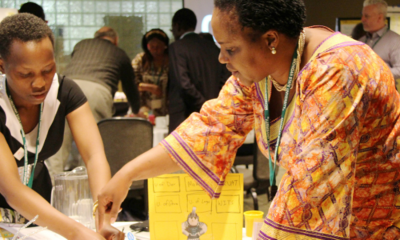
 General2 weeks ago
General2 weeks agoAfrican Futures Research Leadership Program: Cohort 5 – Call for Scholars
-

 General2 weeks ago
General2 weeks agoNow Open: CADFP Project Requests
